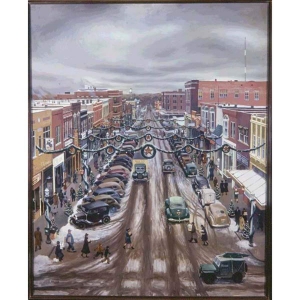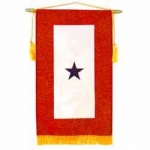
John P. Falter (1910-1982)|Falls City, Nebraska at Christmas, 1946|Cover illustration for The Saturday Evening Post (December 21, 1946)|Oil on canvas|Nebraska State Historical Museum, 10645-4562
What a difference there is looking at John P. Falter’s 1946 oil painting of Falls City. Nebraska at Christmas, versus The Saturday Evening Post cover it became.
For those of us who live where winter darkens the sky and grays out the light and the landscape, Falter’s view of Falls City’s 1946 main street looks chilly enough to be real. In terms of other of Falter’s Nebraska scenes, this one is positively crowded with automobiles and people.
Falter moved from Nebraska (where he was born and raised) and Kansas (where he had his early art training at the Kansas City Art Institute) to New York late in the 1920s ostensibly to study at the Art Students League where he had a scholarship. But he lasted there only a month, finding it difficult to become use to the abundance of people and the overwhelming nature of the city. To pay his way, Falter found work as an illustrator, continued his studies, and settled in New Rochelle, NY where a colony of illustrators already existed. Falter created his first Saturday Evening Post cover in 1943, the same year he enlisted in the United States Navy.
When Falter began to do Post covers he was well aware of the precedents set by J. C. Leyendecker (1874-1951) and Norman Rockwell (1894-1978) both of whom also lived in New Rochelle, although Rockwell had moved to Vermont in 1939. Falter nevertheless determined to base his Post cover illustrations on his own experiences–mid-western or big city. For his second Post cover he painted a mid-western farm wife standing at her mailbox reading a letter from her son overseas. Other covers, as we’ve already seen, were based on Falter’s life and work experiences in and around New York City. [See Exploring Illustration posting for November 5, 2009.]
For this holiday cover, published December 12, 1946, Falter chose to create a bird’s-eye view of his home town Falls City, Nebraska. At that time the town was a decade shy of its centennial and approaching the largest population it would know.* The holiday season brought a bustle of cars and people to its decorated streets. In Falter’s over view, Main street is prominently decorated with a progression of garland linked wreath wrapped five-pointed red stars. Boughs of evergreens wrap the town’s lamp posts and small decorated Christmas trees march regularly along the sidewalk’s edge.
For all the holiday normalcy along the street, I cannot help thinking about the sons, brothers, and husbands of this and other communities all over the United States who were home or coming home from their war duty after peace had been won in 1945 and those who would never come home. During the war, the government issued military service banners to the families of service men and women.** When a member of the armed forces was killed in action, a gold star replaced the blue on a white field. For all the wonder along Main Street in Falls City, Nebraska, those red stars overarching the street remind me of the service rendered by the people of this community and all the others in the country to that war effort and this one too, and the simple joy those who survived must have felt (feel) at being home.

Happy Holidays.
* In the 1950 census, Falls City would top out at 6,200 residents. The population was 4,671 at the time of the 2000 census.
** This tradition began when an army captain made such a flag to denote his sons’ service during WWI and became an official banner in September of 1917.
December 24, 2009
By Joyce K. Schiller, Curator, Rockwell Center for American Visual Studies
Norman Rockwell Museum






